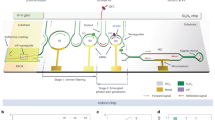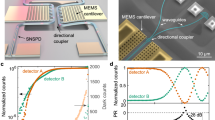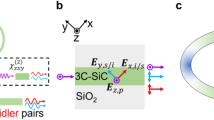Abstract
Silicon photonics could soon be used to create the vast numbers of physical qubits needed to achieve useful quantum information processing by leveraging mature complementary metal–oxide–semiconductor (CMOS) manufacturing to miniaturize optical devices for generating and manipulating quantum states of light. However, the development of practical silicon quantum-photonic integrated circuits faces challenges related to high sensitivity to process and temperature variations, free-carrier and self-heating nonlinearities, and thermal crosstalk. These issues have been partially addressed with bulky off-chip electronics, but this sacrifices many benefits of a chip-scale platform. Here we report an electronic–photonic quantum system-on-chip that consists of quantum-correlated photon-pair sources stabilized via on-chip feedback control circuits and is fabricated in a commercial 45-nm CMOS microelectronics foundry. We use non-invasive photocurrent sensing in a tunable microring cavity photon-pair source to actively lock it to a fixed-wavelength pump laser while operating in the quantum regime, enabling large-scale microring-based quantum systems. We also show that these sources maintain stable quantum properties and operate reliably in a practical setting with many adjacent photon-pair sources creating thermal disturbances on the same chip. Such dense integration of electronics and photonics enables implementation and control of quantum-photonic systems at the scale needed to achieve useful quantum information processing with CMOS-fabricated chips.
This is a preview of subscription content, access via your institution
Access options
Access Nature and 54 other Nature Portfolio journals
Get Nature+, our best-value online-access subscription
$32.99 / 30 days
cancel any time
Subscribe to this journal
Receive 12 digital issues and online access to articles
$119.00 per year
only $9.92 per issue
Buy this article
- Purchase on SpringerLink
- Instant access to full article PDF
Prices may be subject to local taxes which are calculated during checkout





Similar content being viewed by others
Data availability
Datasets generated during the current study are available from the corresponding authors upon reasonable request.
References
Rudolph, T. Why I am optimistic about the silicon-photonic route to quantum computing. APL Photon. 2, 030901 (2017).
Wang, J., Sciarrino, F., Laing, A. & Thompson, M. G. Integrated photonic quantum technologies. Nat. Photon. 14, 273–284 (2020).
Adcock, J. C. et al. Advances in silicon quantum photonics. IEEE J. Sel. Topics Quantum Electron. 27, 1–24 (2020).
Giewont, K. et al. 300-mm monolithic silicon photonics foundry technology. IEEE J. Sel. Topics Quantum Electron. 25, 8200611 (2019).
Rakowski, M. et al. 45nm CMOS-silicon photonics monolithic technology (45CLO) for next-generation, low power and high speed optical interconnects. In Optical Fiber Communication Conference (OFC) 2020, OSA Technical Digest T3H.3 (Optica Publishing Group, 2020).
Sharping, J. E. et al. Generation of correlated photons in nanoscale silicon waveguides. Opt. Express 14, 12388–12393 (2006).
Harada, K.-i et al. Generation of high-purity entangled photon pairs using silicon wire waveguide. Opt. Express 16, 20368–20373 (2008).
Clemmen, S. et al. Continuous wave photon pair generation in silicon-on-insulator waveguides and ring resonators. Opt. Express 17, 16558–16570 (2009).
PsiQuantum team. A manufacturable platform for photonic quantum computing. Nature 641, 876–883 (2025).
Bian, Y. et al. 3D integrated laser attach technology on a 300-mm monolithic CMOS silicon photonics platform. IEEE J. Sel. Topics Quantum Electron. 29, 8200519 (2023).
Mahmudlu, H. et al. Fully on-chip photonic turnkey quantum source for entangled qubit/qudit state generation. Nat. Photon. 17, 518–524 (2023).
Kim, J.-H. et al. Hybrid integration of solid-state quantum emitters on a silicon photonic chip. Nano Lett. 17, 7394–7400 (2017).
Katsumi, R. et al. Quantum-dot single-photon source on a CMOS silicon photonic chip integrated using transfer printing. APL Photon. 4, 036105 (2019).
Larocque, H. et al. Tunable quantum emitters on large-scale foundry silicon photonics. Nat. Commun. 15, 5781 (2024).
Eltes, F. et al. A BaTiO3-based electro-optic Pockels modulator monolithically integrated on an advanced silicon photonics platform. J. Lightwave Technol. 37, 1456–1462 (2019).
Eltes, F. et al. An integrated optical modulator operating at cryogenic temperatures. Nat. Mater. 19, 1164–1168 (2020).
Wang, X., Valdez, F., Mere, V. & Mookherjea, S. Monolithic integration of 110 GHz thin-film lithium niobate modulator and high-Q silicon microring resonator for photon-pair generation. In 2022 Conference on Lasers and Electro-Optics (CLEO) 1–2 (IEEE, 2022).
Wang, X., Mere, V., Valdez, F. & Mookherjea, S. Integrated electro-optic control of biphoton generation using hybrid photonics. Opt. Quantum 1, 19–25 (2023).
Pernice, W. H. et al. High-speed and high-efficiency travelling wave single-photon detectors embedded in nanophotonic circuits. Nat. Commun. 3, 1325 (2012).
Akhlaghi, M. K., Schelew, E. & Young, J. F. Waveguide integrated superconducting single-photon detectors implemented as near-perfect absorbers of coherent radiation. Nat. Commun. 6, 8233 (2015).
Najafi, F. et al. On-chip detection of non-classical light by scalable integration of single-photon detectors. Nat. Commun. 6, 5873 (2015).
Carolan, J. et al. Scalable feedback control of single photon sources for photonic quantum technologies. Optica 6, 335–340 (2019).
Caspani, L. et al. Integrated sources of photon quantum states based on nonlinear optics. Light Sci. Appl. 6, e17100 (2017).
Savanier, M., Kumar, R. & Mookherjea, S. Photon pair generation from compact silicon microring resonators using microwatt-level pump powers. Opt. Express 24, 3313–3328 (2016).
Silverstone, J. W. et al. Qubit entanglement between ring-resonator photon-pair sources on a silicon chip. Nat. Commun. 6, 7948 (2015).
Faruque, I. I., Sinclair, G. F., Bonneau, D., Rarity, J. G. & Thompson, M. G. On-chip quantum interference with heralded photons from two independent micro-ring resonator sources in silicon photonics. Opt. Express 26, 20379–20395 (2018).
Lu, L. et al. Three-dimensional entanglement on a silicon chip. npj Quantum Inf. 6, 30 (2020).
Llewellyn, D. et al. Chip-to-chip quantum teleportation and multi-photon entanglement in silicon. Nat. Phys. 16, 148–153 (2020).
Arrazola, J. M. et al. Quantum circuits with many photons on a programmable nanophotonic chip. Nature 591, 54–60 (2021).
Wang, J. et al. Multidimensional quantum entanglement with large-scale integrated optics. Science 360, 285–291 (2018).
Bao, J. et al. Very-large-scale integrated quantum graph photonics. Nat. Photon. 17, 573–581 (2023).
Yard, P. et al. On-chip quantum information processing with distinguishable photons. Phys. Rev. Lett. 132, 150602 (2024).
Horikawa, T. et al. Resonant wavelength variation modelling for microring resonators based on fabrication deviation analysis. In 2017 European Conference on Optical Communication (ECOC) 1–3 (IEEE, 2017).
Jayatilleka, H. et al. Post-fabrication trimming of silicon photonic ring resonators at wafer-scale. J. Lightwave Technol. 39, 5083–5088 (2021).
Dinu, M., Quochi, F. & Garcia, H. Third-order nonlinearities in silicon at telecom wavelengths. Appl. Phys. Lett. 82, 2954–2956 (2003).
Soref, R. A. & Bennett, B. R. Electrooptical effects in silicon. IEEE J. Quantum Electron. 23, 123–129 (1987).
Almeida, V. R. & Lipson, M. Optical bistability on a silicon chip. Optics Lett. 29, 2387–2389 (2004).
Priem, G. et al. Optical bistability and pulsating behaviour in silicon-on-insulator ring resonator structures. Opt. Express 13, 9623–9628 (2005).
Sun, C. et al. A 45 nm CMOS-SOI monolithic photonics platform with bit-statistics-based resonant microring thermal tuning. IEEE J. Solid-State Circuits 51, 893–907 (2016).
Guo, K. et al. Nonclassical optical bistability and resonance-locked regime of photon-pair sources using silicon microring resonator. Phys. Rev. Appl. 11, 034007 (2019).
Xu, Q. & Lipson, M. Carrier-induced optical bistability in silicon ring resonators. Opt. Lett. 31, 341–343 (2006).
Johnson, T. J., Borselli, M. & Painter, O. Self-induced optical modulation of the transmission through a high-Q silicon microdisk resonator. Opt. Express 14, 817–831 (2006).
Chen, S., Zhang, L., Fei, Y. & Cao, T. Bistability and self-pulsation phenomena in silicon microring resonators based on nonlinear optical effects. Opt. Express 20, 7454–7468 (2012).
Stojanović, V. et al. Monolithic silicon-photonic platforms in state-of-the-art CMOS SOI processes. Opt. Express 26, 13106–13121 (2018).
Orcutt, J. S. et al. Open foundry platform for high-performance electronic-photonic integration. Opt. Express 20, 12222–12232 (2012).
Sun, C. et al. Single-chip microprocessor that communicates directly using light. Nature 528, 534–538 (2015).
Sun, C. et al. TeraPHY: an O-band WDM electro-optic platform for low power, terabit/s optical I/O. In 2020 IEEE Symposium on VLSI Technology 1–2 (IEEE, 2020).
Wade, M. et al. TeraPHY: a chiplet technology for low-power, high-bandwidth in-package optical I/O. IEEE Micro 40, 63–71 (2020).
Wade, M. et al. An error-free 1 Tbps WDM optical I/O chiplet and multi-wavelength multi-port laser. In Optical Fiber Communication Conference (OFC) 2021 F3C.6 (Optica Publishing Group, 2021).
Gentry, C. M. et al. Quantum-correlated photon pairs generated in a commercial 45 nm complementary metal-oxide semiconductor microelectronic chip. Optica 2, 1065–1071 (2015).
Gentry, C. M. et al. Monolithic source of entangled photons with integrated pump rejection. In Conference on Lasers and Electro-Optics, OSA Technical Digest JTh4C.3 (Optica Publishing Group, 2018).
Wade, M. T. et al. 75% efficient wide bandwidth grating couplers in a 45 nm microelectronics CMOS process. In 2015 IEEE Optical Interconnects Conference (OI) 46–47 (IEEE, 2015).
Notaros, J. et al. Ultra-efficient CMOS fiber-to-chip grating couplers. In 2016 Optical Fiber Communications Conference and Exhibition (OFC) 1–3 (IEEE, 2016).
Atabaki, A. H., Meng, H., Alloatti, L., Mehta, K. K. & Ram, R. J. High-speed polysilicon CMOS photodetector for telecom and datacom. Appl. Phys. Lett. 109, 111106 (2016).
Hosseini, E. S., Yegnanarayanan, S., Atabaki, A. H., Soltani, M. & Adibi, A. Systematic design and fabrication of high-Q single-mode pulley-coupled planar silicon nitride microdisk resonators at visible wavelengths. Opt. Express 18, 2127–2136 (2010).
Shainline, J. M. et al. Depletion-mode carrier-plasma optical modulator in zero-change advanced CMOS. Opt. Lett. 38, 2657–2659 (2013).
Grillanda, S. & Morichetti, F. Light-induced metal-like surface of silicon photonic waveguides. Nat. Commun. 6, 8182 (2015).
Alloatti, L. & Ram, R. J. Resonance-enhanced waveguide-coupled silicon-germanium detector. Appl. Phys. Lett. 108, 071105 (2016).
Ong, J. R., Kumar, R., Aguinaldo, R. & Mookherjea, S. Efficient CW four-wave mixing in silicon-on-insulator micro-rings with active carrier removal. IEEE Photon. Technol. Lett. 25, 1699–1702 (2013).
Savanier, M., Kumar, R. & Mookherjea, S. Optimizing photon-pair generation electronically using a p-i-n diode incorporated in a silicon microring resonator. Appl. Phys. Lett. 107, 131101 (2015).
Gray, D. et al. Thermo-optic multistability and relaxation in silicon microring resonators with lateral diodes. Phys. Rev. Appl. 14, 024073 (2020).
Xie, Y. et al. Thermally-reconfigurable silicon photonic devices and circuits. IEEE J. Sel. Topics Quantum Electron. 26, 3600220 (2020).
Sun, C., Timurdogan, E., Watts, M. R. & Stojanović, V. Integrated microring tuning in deep-trench bulk CMOS. In 2013 Optical Interconnects Conference 54–55 (IEEE, 2013).
Collins, M. J. et al. Integrated spatial multiplexing of heralded single-photon sources. Nat. Commun. 4, 2582 (2013).
Milanizadeh, M., Aguiar, D., Melloni, A. & Morichetti, F. Canceling thermal cross-talk effects in photonic integrated circuits. J. Lightwave Technol. 37, 1325–1332 (2019).
Gurses, B. V., Fatemi, R., Khachaturian, A. & Hajimiri, A. Large-scale crosstalk-corrected thermo-optic phase shifter arrays in silicon photonics. IEEE J. Sel. Topics Quantum Electron. 28, 6101009 (2022).
Seok, T. J., Kwon, K., Henriksson, J., Luo, J. & Wu, M. C. Wafer-scale silicon photonic switches beyond die size limit. Optica 6, 490–494 (2019).
Jin, W., Feshali, A., Paniccia, M. & Bowers, J. E. Seamless multi-reticle photonics. Opt. Lett. 46, 2984–2987 (2021).
Lau, J. H. Recent advances and trends in advanced packaging. IEEE Trans. Compon. Packag. Manuf. Technol. 12, 228–252 (2022).
Shekhar, S. et al. Roadmapping the next generation of silicon photonics. Nat. Commun. 15, 751 (2024).
Mahajan, R. et al. Embedded multidie interconnect bridge—a localized, high-density multichip packaging interconnect. IEEE Trans. Compon. Packag. Manuf. Technol. 9, 1952–1962 (2019).
Bienfang, J. C. et al. Single-photon sources and detectors dictionary (US Department of Commerce, National Institute of Standards and Technology, 2023).
Beck, M. Comparing measurements of g(2)(0) performed with different coincidence detection techniques. J. Opt. Soc. Am. B 24, 2972–2978 (2007).
Cabanillas, J. F. et al. Monolithically integrated high-order vernier filters and tuning circuits for electronic-photonic quantum system-on-chip. In Conference on Lasers and Electro-Optics, Technical Digest Series STh4H.4 (Optica Publishing Group, 2022).
Acknowledgements
This work was funded by NSF EQuIP program grant no. 1842692, Packard Fellowship no. 2012-38222, NSF FuSe TG award no. 2,235,466 and the Catalyst Foundation. We thank Ayar Labs and GlobalFoundries for chip fabrication and the Berkeley Wireless Research Center for chip-testing support.
Author information
Authors and Affiliations
Contributions
I.W. and J.M.F.C. designed the photonic components. D.K. and I.W. designed the electronic–photonic system layout. D.K., S.B., C.A. and P.Z. designed the on-chip electronic circuits. S.B. created and supported the electronic–photonic chip design infrastructure and tool flow. D.K. performed the system integration; package design, control firmware and software development; and initial hardware bring-up. D.K., A.R. and Ð.G. collected and analysed the classical electro-optical characterization data. A.R. developed and performed the quantum characterization experiments, and D.K. contributed the data analysis code. A.R. and D.K. conceptualized and conducted the system-level demonstrations. I.W., Ð.G., D.K. and A.R. developed and validated the photon-pair source device model. The paper was prepared by D.K., A.R., I.W. and Ð.G. D.K., A.R. and I.W. created the figures. All authors contributed to the review of the paper. M.A.P., P.K. and V.M.S. supervised and conceptualized the project. These authors contributed equally: D.K., I.W. and A.R.
Corresponding authors
Ethics declarations
Competing interests
The authors declare no competing interests.
Peer review
Peer review information
Nature Electronics thanks Ali Elshaari, Ryota Katsumi and Jianwei Wang for their contribution to the peer review of this work.
Additional information
Publisher’s note Springer Nature remains neutral with regard to jurisdictional claims in published maps and institutional affiliations.
Extended data
Extended Data Fig. 1 High-Extinction Pump Rejection Filter.
(a) Measurement setup for characterizing the extinction ratio of the integrated pump rejection filters. The filters are aligned by using an EDFA in place of the tunable laser to intentionally generate broadband ASE noise, and then maximizing the drop port power meter readings using a Nelder-Mead optimization algorithm. The tunable laser is then swapped back in to take a transmission spectrum. (b) Normalized transmission spectrum of input to drop port response of the aligned filter using a series of stitched continuous sweeps with varying power meter range settings (blue curve) showing ~ 95 dB extinction that is limited by ASE noise of the laser source passing through the aligned passband. When an external ASE filter is enabled and the integration time is increased, the noise floor falls below the minimum detectable level of the power meter, indicating > 100 dB extinction at an offset wavelength of one FSR of the photon-pair source, which is required for fully on-chip pump filtering (red points). The filter uses a Vernier scheme to extend the FSR, resulting in less extinction (~ 60 dB) at the FSRs of the cascaded sub-filters, which are selected not to align with either the pump laser or other single-photon channel when the pump rejection filter is aligned to a particular signal or idler output wavelength. Limited heater tuning range prevented the on-chip filters from being aligned to a photon-pair source resonance wavelength on all tested chips, which is correctable by improving the source and filter heater designs and slightly adjusting the microring radii to target specific resonance wavelengths, reducing the initial error between the source and filter resonances. We have characterized the insertion loss of this filter to be < 1 dB using measurements at a separate test site with through port and drop port grating couplers oriented in the same direction, allowing the same fiber to measure both ports one at a time74.
Supplementary information
Supplementary Information
Supplementary Sections 1–5.
Rights and permissions
Springer Nature or its licensor (e.g. a society or other partner) holds exclusive rights to this article under a publishing agreement with the author(s) or other rightsholder(s); author self-archiving of the accepted manuscript version of this article is solely governed by the terms of such publishing agreement and applicable law.
About this article
Cite this article
Kramnik, D., Wang, I., Ramesh, A. et al. Scalable feedback stabilization of quantum light sources on a CMOS chip. Nat Electron 8, 620–630 (2025). https://doi.org/10.1038/s41928-025-01410-5
Received:
Accepted:
Published:
Issue date:
DOI: https://doi.org/10.1038/s41928-025-01410-5
This article is cited by
-
Chip-fiber-chip quantum teleportation in a star-topology quantum network
Light: Science & Applications (2025)
-
Scaling quantum computers with electronic–photonic chips
Nature Electronics (2025)
-
Integrated electronic controller for dynamic self-configuration of photonic circuits
Light: Science & Applications (2025)



